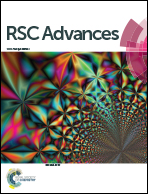Tuning the hydride reductions catalyzed on metal nanoparticle surfaces†
Abstract
Electrostatic interactions between the nanoparticle surface and reactants in solution have a more predominant impact on the catalytic activity on the nanoparticle surface than the size of the nanoparticle, which consequently influences the competitive transfer hydrogenation of water and nitro compounds from the activated hydride on nanoparticles. The higher surface charge density of a smaller nanoparticle led to a stronger repulsion from the nanoparticle surface, resulting in a slower approach of reactants, such as nitrophenol, to the nanoparticles. The generation of hydrogen overtook the nitrophenol reduction. However, larger nanoparticles presented a more heterogeneous surface coating than a smaller one even though both had a similar average surface charge, which provided some unprotected metal surfaces for nitrophenol reduction to proceed. Consequently, we observed an inverse dependence of the catalytic reaction on the surface area, i.e., the smaller the nanoparticles, the larger the surface area per unit mass, the slower the catalytic reaction of nitrophenol reduction. However, when the electrostatic repulsion was not obvious, decreased particle size had no effect on the reaction rates of the same reaction. As a competing reaction to the nitrophenol reduction, hydrogen generation depended strongly on the surface area of nanoparticles.



 Please wait while we load your content...
Please wait while we load your content...